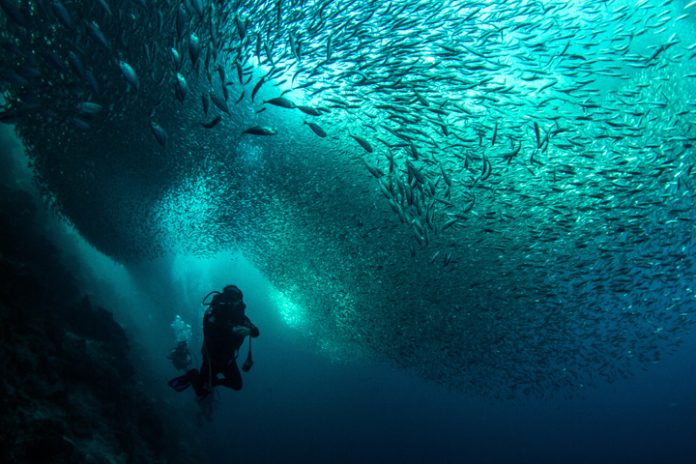(BusinessMirror)

They may not be the most popular, but sardines are the most abundant of all fish species, and they have been part of the human diet for a long time. Because of their abundance, they are a very important family of epipelagic fish among the most commonly caught fish in the Philippines.
Rich or poor, people eat sardines. A good source of protein, sardines are delicious, easy to cook and very affordable. In fact, they may be the most undervalued fish.
In the Philippines a kilo of fresh sardine costs P80 to P180. Smoked sardines cost around P5 to P10 a piece, depending on the size. In cans, which are widely distributed and accessible in retail stores and probably the most popular food, they cost around P17 to P22, making it one of the most affordable foods.
Sardines are harvested on a massive scale by commercial fishers. They are also consumed by larger predators in the open sea, yet, their population keeps bouncing back.
Threatened species
Lately, overfishing and climate change are fast catching up with these highly resilient species.
“Even the fishes in canned sardines are getting smaller and smaller, a sign there is really a problem,” said Gloria Estenzo Ramos, vice president of Oceana Philippines.
While there is no sardine-supply shortage yet, the government and Oceana Philippines are moving to protect and conserve sardines, to ensure that they will not go extinct, an official of the Department of Agriculture-Bureau of Fisheries and Aquatic Resources (DA-BFAR) said.
Capture Fisheries Technology Division Chief Rafael Ramiscal said there is a need to enhance existing policies to prevent overfishing, allow fish stocks to repopulate and replenish the country’s fishing grounds.
“Sagip Sardinas”, a nationwide campaign to promote sustainable production of sardines, was launched by Oceana Philippines and DA-BFAR late last month to put in place a National Sardine Management Framework Plan (NSMFP).
The target is to come up with a science-based NSMFP by October for implementation next year.
The NSMFP will serve as the country’s first sardine fisheries roadmap.
Strategic planning
Ramiscal said the formulation of the NSMFP would be based on good science, realistic policy and efficient governance and supported with adequate budget support.
“The plan will be developed through a consultative process that will involve fishers, local governments, scientists, traders, processors, non-governmental organizations and consumers,” he added.
“We need to consider correct identification of species and genetic stock, determine fish abundance, geophysical process and lifecycle, including drivers, such as environment and other ecosystem processes,” he said.
Among the policies being eyed include stricter regulatory process in catching or harvesting sardines—to leave behind enough bigger-sized spawners, catch only those that have reproduced at least once and adjust according to stock and environmental conditions.
Forage fish
Sardines are forage fish, and their very existence is key to the survival of a lot of other marine wildlife, including pelagic birds, Ramos said.
Sardines are at the base of the food chain, next to plankton, making their existence very important for the survival of a lot of other bigger fishes and predators on top of the food chain.
“All Filipinos can relate to canned sardines. But not all really know about the fish,” Ramos said.
Commercially viable fish, like mackerel and tuna, sharks and dolphins and whales, feed and survive on this forage fish.
The extinction of sardines, being the primary source of food in the ocean, could also spell the extinction of the most commercially viable fish, like tuna and mackerel, and even sharks, dolphins and large marine mammals, which play very important ecosystem functions in the oceans.
Pelagic birds or sea birds, which frequent coastal waters and the open sea, like sea gulls, pelicans and albatrosses, also rely on the abundance of sardines and other pelagic fish.
Pelagic birds need sardines not only for themselves, but for their youngs to ensure their species will continue to thrive.
Through the Sagip Sardinas campaign, Ramos said they intend to address the unsustainable fishing practices, both by commercial fishing companies and small-scale fishers, through science-based fisheries management.
The challenge is to strike a balance between the supply and demand for sardines, while addressing the challenge posed by the stiff competition between man and the other predators in the wild.
Tuna industry
While sardine-canning factories reap the benefits of having abundant supply of the fish, overfishing eventually threatens the multi-billion-dollar tuna industry.
Being a major producer of tuna, the Philippines is expected to feel the brunt of overfishing sardines, once the tuna catch starts to go down, said Dr. Jose Ingles, member of the Sardine Industry’s National Mountaineering Federation of the Philippines technical working group and consultant of Environmental Defense Fund
To ensure a healthy tuna population, sardine population should also stay healthy—enough for both humans and other predators.
Tuna, whether fresh or canned, is being exported by the Philippines. The tuna industry is a major employer, particularly in Mindanao, where most of the canning factories are situated.
Over production?
Milagros Morales, officer in charge of the BFAR, said sardines are economically important fish species. Citing Philippine Statistics Authority (PSA) data, Morales said an average volume of 355,000 metric tons (MT) are harvested by commercial and small-scale fishers annually, generating an estimated value of P10.45 billion.
From the DA-BFAR’s own Fisherfolk Registration System, she reported there are over 800,000 fisherfolk engaged in capture fishing. “That is nearly half of the 1.7 million registered fisherfolk across the country, almost a million people dependent on sardines and other fish for their everyday living,” Morales said.
Filipinos, she said, consume around 2.6 grams of sardine a day, or almost a kilo a year.
“Certainly, with the affordability and abundance of sardines, the industry is one of the fisheries subsectors that can help us achieve our food-security goals,” she pointed out.
Through the BFAR, the government wants to keep the sardine resource at a healthy and ecologically sound number, she said.
Undervalued
While sardines are one of the most economically important fish, they are also the most undervalued fish in the planet.
Because they are very affordable, Ingles said, in Malaysia, where he worked for a time, tons of sardines are used as fertilizer in palm-oil plantations.
“Palm-oil plantations use sardines as fertilizers. Tons of these fish are caught every day, hauled off and dumped in palm-oil plantations to fertilize the soil,” he said.
In the Philippines fresh or processed, including smoked sardines or tinapa, sardines are commonly served as a pantawid-gutom for the tens of thousands of families with limited budget.
Sardines are also used as main ingredients of some popular condiments, such as fish sauce, or bagoong and patis, an industry that provides jobs and livelihood opportunities in support of the fisheries sector, by producing these important fish by-products.
Major sardine species
The Philippines is blessed with a diverse species of sardines. In fact, the Sardinella tawilis, a freshwater sardine, is exclusively found in Taal Lake. Sardinella is the diminutive of the Greek sarda, meaning literally “little sardine”.
Ideally, a sardine is caught upon the age of maturity, which is between four months to 1 year, Flores said. Spawning of sardines happens from October to December and February to September.
There are six major species of sardine in the Philippines, said Jimely Flores, senior marine scientist of Oceana Philippines.
They are Sardinella lemuru, Sardinela gibbosa, Sardinella fimbriata, Dussumieeria acuta, Amblygaster sirm and Sardinella albella.
Sardine species are called by different names: tamban, tuloyu, tunsoy, law-law, turay, tabagak, manamsi and dilat.
Climate-change effect
Sardines’ life cycle is impacted by climate change. Besides unsustainable fishing practices, the change in weather pattern, the intensifying typhoons and increase in ocean temperature could cause the extinction of a lot of fish species, including sardines, Flores said.
An initial study conducted by Oceana revealed sardine production has changed over the last decade. In 2004 Palawan was the top producer of sardines, with close to 15,000 tons annual production based on a survey in fish landings by the PSA.
Zamboanga del Norte comes next with an annual production of about 10,000 tons. Other top producers are Zamboanga City, Masbate, Tawi-Tawi, Iloilo, Negros Occidental, Sorsogon, Misamis Oriental and Camarines Sur.
In 2014 Palawan’s annual sardine production was overtaken by Zamboanga del Norte, with a record production of over 20,000 MT. Palawan produced less than 10,000 tons.
Masbate, Sorsogon, Iloilo, Zamboanga City, Negros Occidental, Tawi-Tawi, Misamis Oriental and Camarines Sur are still among the top 10 producers.
Flores said, surprisingly, Manila Bay has been found to have abundant sardine stock, along with the fishing grounds of Quezon, Bicol and Northern Samar; the Visayan Sea, Northern Sulu Sea, South Sulu Sea and Palawan.
A more thorough study on the biology of sardines and the effect of climate change is apparently needed to better understand and come up with ways to protect these lowly fish against threats that could lead to devastating economic impact.
According to Ramos, while there appears to be an increasing trend in the production of sardines since 2000, telltale signs of overfishing of many local stocks cannot be ignored.
While she said the closed season over the past five years has been successfully implemented in the Visayan Sea, Tañon Strait and Zamboanga, policies need to be enhanced and strictly enforced.
“Closed seasons are not enough. Additional management tools under the amended Fisheries Code are needed,” she said.
Oceana believes that by adopting a science-based strategy, local sardines will continue to thrive, support other marine wildlife and feed the world at the same time.
